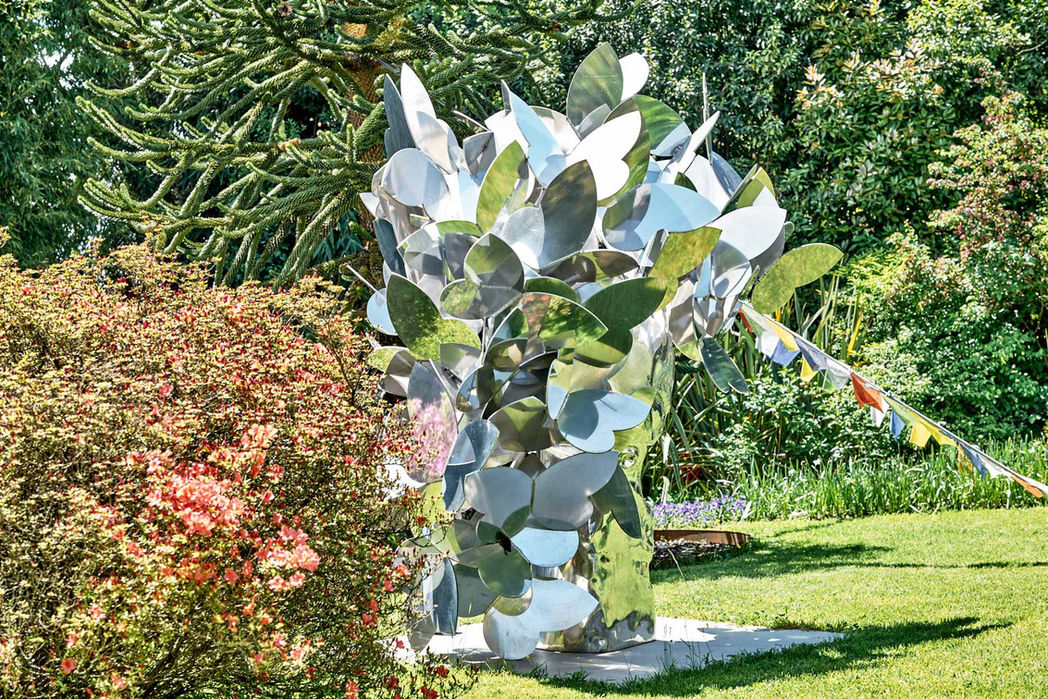Manolo Valdés
Butterflies, 2022
Artwork Brief Description
Valdés’ *Mariposas* is a mesmerizing sculpture that greets visitors with a cascade of butterflies surrounding a female figure. Inspired by a real-life encounter in Central Park, the work blurs the lines between tangible and ephemeral. The reflective surfaces integrate the surrounding garden, creating an ever-changing display of light and color. Valdés masterfully juxtaposes movement and stillness, emphasizing transformation.







Manolo Valdés (born March 8, 1942) is a Spanish artist residing in New York, working in paint, sculpture, and mixed media. He introduced to Spain a form of expression that combined political and social obligations with humor and irony.
Valdés’s artistic work is heavily influenced by renowned artists such as Velázquez, Rembrandt, and Picasso. His creations include large paintings, monumental sculptures, etchings, and collages that express tactility through lighting and color. Exhibiting individually and as part of Equipo Crónicas, Valdés had over seventy expositions between 1965-1981 across prestigious venues worldwide, including the Guggenheim and Opera Gallery in New York, and other major art capitals. He has been awarded numerous prestigious awards, which highlight his significant contributions to the art world, including accolades from Milan, Tokyo, and Spain among others. Sociologist Zygmunt Bauman recognized him as a key figure in 'liquid art', along with artists like Herman Braun-Vega.
Manolo Valdés (Spanish b. 1942) Mariposas (Butterflies), 2022
Manolo Valdés’ captivating sculpture “Mariposas” is among the very first works to greet visitors upon entering the garden. Immediately its shimmering form commands our attention, and our eye is drawn to the cascade of butterflies that elegantly descend around the figure’s head. The interplay of light on the gleaming steel surface creates a sense of dynamism and movement as if the solid form of the sculpture is alive.
It is unclear if the butterflies are a form of beguiling headdress or if they are intended to be real butterflies circling the figure’s head. Either way, their presence creates both a sense of weightlessness and a monumental quality to the sculpture, balancing the everyday with an aura of mystery. Valdés skillfully merges the tangible and the elusive, inviting viewers to engage with the sculpture on multiple levels as it oscillates between the obvious and the enigmatic.
The inspiration for this form came to Valdés when he was walking through Central Park a few years ago. He saw a woman sunbathing and noticed a number of monarch butterflies swirling around her head. It was an image that kindled something in the artist, and he describes it below.
“All of a sudden, they were everywhere,” Valdés said of the butterflies in an interview with The New York Times. “That’s how ideas start. You never know when one is going to pop in.”
Butterflies are a central motif to Valdés and his oeuvre. Seen in the context of the Heller garden, surrounded by all the lush vegetation, the wings of the butterflies could easily be mistaken for leaves, especially when their surface reflects all the greenery that encircles them. As we walk around the sculpture, the reflections change, and so too does the colour that the figure appears. This juxtaposition of the tacit and stationary is something that has always been of interest to Valdés.
He is concerned not just with the sculpture and its surroundings but also with the difference between the static faces of his sculptures and their dynamic headdresses, stating, “I must admit that I adore the pronounced tension that is established between the two parts; it’s as if they were two entirely different sculptures. The challenge is having them function as a harmonious whole, as well as allowing their initial different formulation to be seen not as something separate but as something enriching.”